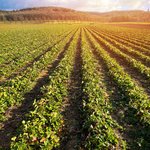Foliar fertilisation in strawberries
In strawberries, the foliar fertilisation is well established since many years. Unfortunately, it is being applied too late, often when symptoms become visible (e.g. for manganese, iron, boron, magnesium).
It is better to practice preventative fertilisation before symptoms occur. It is worth to remember that the hidden hunger (not deficiency visible) can reduce quality and yield as well. The leaf analysis can help to identify the level of nutrients.
Availability of nutrients

Many parameters in the soil can limit the availability of nutrients – high pH-values can block micro-nutrients, low pH-values can block macro-nutrients. But also dry and cold weather conditions, soil texture and some nutrient antagonisms (e.g. oversupply with potassium vs. magnesium and calcium) can lead to a deficiency of nutrients.
Specific nutrient demands of strawberries – iron chloroses
Strawberries are sensitive to iron chlorosis. Iron deficiency symptoms are yellowing of the youngest leaves and dark leaf veins. Please consider Lebosol®-HeptaIron as a source of iron and for manganese needs we recommand Lebosol®-Manganese 500 SC.
Lebosol®-HeptaIron is widely tank miscible and can also be used in organic production.
Flowering, fruit set and yield optimisation
The micro-nutrients boron and zinc are essential for the fruit setting. For optimized yield and quality our products Lebosol®-Robustus SC (boron + calcium) and Lebosol® Zinc 700 SC can be applied either before the flowering, after the harvest or with new planting in autumn. In addition, a sufficient boron supply can reduce the appearance of deformed fruits.
Shelf life of strawberries
Lebosol®-Calcium-Forte SC, chloride free, can improve the calcium content in the fruit and enhance quality and shelf life. It includes also manganese and zinc.
Planting new strawberry fields

The young plants need optimal growing conditions from planting until winter dormancy. The flower buds and yield potential is usually determined in the early autumn. Therefore an attention should be focused on stress reduction and root growth development.
For this purpuse we have the following recommandations with amino acids and the product Aminosol®:
- The small plants can be dipped in a 1 % Aminosol®-solution for at least 15 minutes before planting
- or to irrigate the plants after planting with a 1 % Aminosol®
The foliar application with phosphorus provides extra energy and encourage plants to develop better root architecture to penetrate the soil and take up vital nutrients.


